Lansium domesticum
Lansium domesticum, commonly known as langsat or lanzones,[2] is a species of tree in the family Meliaceae with commercially cultivated edible fruits. The species is native to Southeast Asia. It is of the family, Meliaceae, and of the Kingdom Plantae.[1]
| Lansium domesticum | |
|---|---|

| |

| |
| Lanzones in the Philippines | |
| Scientific classification | |
| Kingdom: | Plantae |
| Order: | Sapindales |
| Family: | Meliaceae |
| Genus: | Lansium |
| Species: | L. domesticum
|
| Binomial name | |
| Lansium domesticum Corrêa
| |
| Synonyms[1] | |
|
List
| |
Lansium Domesticum Media
Botanical illustration of L. domesticum leaves, flowers, and fruits, from Flora de Filipinas (c. 1837) by the Spanish friar and botanist Manuel Blanco
A Lansium domesticum agroforest in Musi Rawas, Sumatra, Indonesia
La Vendedora de Lanzones ("The Lanzones Seller") by the Filipino painter Félix Resurrección Hidalgo (1875) in the Museo del Prado
Street dancers in traditional Kamigin Manobo attire in the Lanzones Festival of Camiguin Island, Philippines
L. domesticum 'Duku' in Malaysia peeled open, note the thick skin
L. domesticum 'Paete' being sold in Paete, Laguna, Philippines
References
- ↑ 1.0 1.1 "Lansium domesticum Corrêa". Plants of the World Online. Royal Botanic Gardens Kew. Retrieved 25 April 2024.
- ↑ Bureau of Product Standards (2007). "Fresh fruits – Lanzones – Grading and classification" (PDF). Philippine National Standard. Department of Trade and Industry, Republic of the Philippines (PNS/BAFPS 54). Archived from the original (PDF) on 2024-02-01. Retrieved 2024-05-07.








